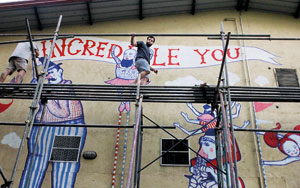A group of artists arranged buckets of paint in a narrow lot between two tall buildings during a roasting noontime hour, reassuring themselves with the reminder that the sunlight presses its palms into this dirt patch of a play area for only a few hours before moving westward.
The unaffected laughter of playing children punctuated the hush of midday. Upon initial glance, these children looked as round-cheeked and excitable as any healthy, school-aged group. However, upon closer examination, one could see the plastic intravenous devices, called cannulas, implanted in their inner elbows. It became clear that this handful of children playing outside were healthier exceptions, not the norm, among the 120 resident patients at Maharagama Children’s Cancer Ward.
 |
| Work in progress. Pic by Aaron Rahkaishi |
The Maharagama Children’s Cancer Ward located on the straightforwardly named Hospital Road is where foreign street artists Aaron Rahkaishi (New Zealand) and Simon Blackfoot (Canada), in conjunction with Sara Afshar (UK), Project Manager of The Razavi Project, had organized a mural project.The theme of the mural was “Circus Sideshow.”
Rahkaishi and Blackfoot initiated their mural project with the aim of decreasing the emotional stress that cancer patients confront daily. “It’s more positive for these kids to see beautiful pictures outside their windows than to stare at a blank wall,” Rahkaishi explains. “And these kids need all the positivity they can get.” After some thought, he adds, “Another reason [for painting this mural] is to provide an alternative to the advertising that bombards us every day. In an urban landscape, most of the art you see in public spaces is advertising. We want to provide an aesthetically pleasing alternative to that.”
The Razavi Project had arranged for scaffolding to be set up alongside the building, allowing the muralists to paint the entirety of the three-storey wall. The artists faced the physical challenge of climbing up the metal rungs with cups of paint held in their hands and paintbrushes clenched between their teeth, only to climb back down again each time they needed a refill of paint. Supporting artist Kichari (USA) confesses, “The metal scaffolding was sturdily constructed, but cold adrenaline shot up from the soles of my feet each time I saw how far the ground was. It took regular doses of silent pep talks to get myself back up to my painting area.“
As the sun departed from the space between the buildings and the oven-like heat grew more tolerable, circus performers revealed their personalities. A portly, bearded, tattooed lady balanced on her dainty toes. A two-headed girl floated through the sky. A half-man, half-fish creature showed off his juggling act.
During two days’ time it took for the mural to be completed, patients and staff at the Cancer Ward kept watch over the process. Afshar notes with satisfaction, “The children showed a great interest in the mural, from its start to its finish. Throughout the duration of painting, I noticed the children peering through the windows with curiosity and awe. One day, when I visited the wards, two of the children excitedly showed me their sketchbooks, where they had copied one of the characters from the wall: the two-headed girl. There are a lot of little smiles from the kids, cleaning staff, and helpers. A few expressed their enthusiasm by signalling two thumbs up at me.”
As the children grew more accustomed to the presence of the muralists, shy faces emerged from behind the windows through which they had been peering. A few of the braver children conversed with the artists. Kichari comments on her interactions, “I was surprised at the kids’ lack of self-pity while they were telling their stories. A boy told me about how his parents died, and how he grew up in an orphanage before he was diagnosed with cancer…All in such a straightforward, factual way.”
Rahkaishi and Blackfoot hope that their cheerful mural will alleviate the distress of the families, as well as that of the patients. Afshar asserts that art is an effective tool in this pursuit. “Often, the hospital experience can be a real struggle for the children and their families,” Afshar explains. “Sadly, many experience difficult emotions, including depression. Visual arts can help to reduce anxiety and painful sensations in children undergoing chemotherapy-related procedures. Art distracts the kids from their illnesses, and helps them experience enjoyment and increased well-being.”
In the final moments before completion of the mural, Rahkaishi painted an important reminder across the top of the wall:”Incredible you.” The circus mural successfully conveys, in colourful manifestation, their hopes that this empowering message will arouse moments of optimism among the children who see the mural from their hospital beds. |


